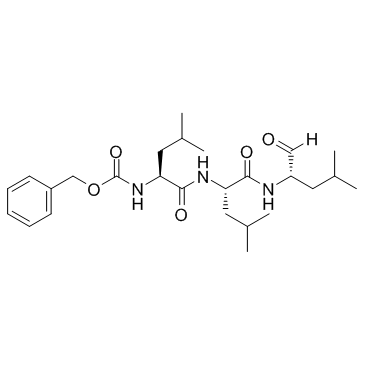蛋白酶体抑制剂

蛋白酶体抑制剂结构式

|
常用名 | 蛋白酶体抑制剂 | 英文名 | MG-132 |
|---|---|---|---|---|
| CAS号 | 133407-82-6 | 分子量 | 475.621 | |
| 密度 | 1.1±0.1 g/cm3 | 沸点 | 682.0±55.0 °C at 760 mmHg | |
| 分子式 | C26H41N3O5 | 熔点 | 80-84℃ (DEC.) | |
| MSDS | 美版 | 闪点 | 366.3±31.5 °C |
|
miR-1236 down-regulates alpha-fetoprotein, thus causing PTEN accumulation, which inhibits the PI3K/Akt pathway and malignant phenotype in hepatoma cells.
Oncotarget 6(8) , 6014-28, (2015) Alpha fetoprotein (AFP) is a clinical biomarker of hepatocellular carcinoma (HCC). Here, we found that miR-1236 is down-regulated, whereas AFP is highly expressed in HCC tissues and cells. We demonstrated that miR-1236 directly targets the 3'UTR of AFP and do... |
|
|
Dominant negative effect of polyglutamine expansion perturbs normal function of ataxin-3 in neuronal cells.
Hum. Mol. Genet. 24(1) , 100-17, (2014) The physiological function of Ataxin-3 (ATXN3), a deubiquitylase (DUB) involved in Machado-Joseph Disease (MJD), remains elusive. In this study, we demonstrate that ATXN3 is required for neuronal differentiation and for normal cell morphology, cytoskeletal or... |
|
|
Hypoxia reduces MAX expression in endothelial cells by unproductive splicing.
FEBS Lett. 588(24) , 4784-90, (2014) The MYC-MAX-MXD network is involved in the regulation of cell differentiation and proliferation. Hypoxia affects the expression levels of several members of this network, but changes specific to MAX expression have so far not been shown. We found that in endo... |
|
|
Beclin 1 restrains tumorigenesis through Mcl-1 destabilization in an autophagy-independent reciprocal manner.
Nat. Commun. 5 , 5637, (2014) Mcl-1 is a unique Bcl-2 family member that plays crucial roles in apoptosis. Apoptosis-unrelated functions of Mcl-1 are however emerging, further justifying its tight regulation. Here we unravel a novel mechanism of Mcl-1 regulation mediated by the haplo-insu... |
|
|
Proteasome functioning in breast cancer: connection with clinical-pathological factors.
PLoS ONE 9(10) , e109933, (2014) Breast cancer is one of four oncology diseases that are most widespread in the world. Moreover, breast cancer is one of leading causes of cancer-related deaths in female population within economically developed regions of the world. So far, detection of new m... |
|
|
Mitochondrial impairment triggers cytosolic oxidative stress and cell death following proteasome inhibition.
Sci. Rep. 4 , 5896, (2014) Dysfunctions of the mitochondria and the ubiquitin-proteasome system, as well as generation of reactive oxygen species (ROS), are linked to many aging-related neurodegenerative disorders. However, the order of these events remains unclear. Here, we show that ... |
|
|
Regulation of 53BP1 protein stability by RNF8 and RNF168 is important for efficient DNA double-strand break repair.
PLoS ONE 9(10) , e110522, (2014) 53BP1 regulates DNA double-strand break (DSB) repair. In functional assays for specific DSB repair pathways, we found that 53BP1 was important in the conservative non-homologous end-joining (C-NHEJ) pathway, and this activity was dependent upon RNF8 and RNF16... |
|
|
DNA damage-specific deubiquitination regulates Rad18 functions to suppress mutagenesis.
J. Cell Biol. 206(2) , 183-97, (2014) Deoxyribonucleic acid (DNA) lesions encountered during replication are often bypassed using DNA damage tolerance (DDT) pathways to avoid prolonged fork stalling and allow for completion of DNA replication. Rad18 is a central E3 ubiquitin ligase in DDT, which ... |
|
|
Exosome-mediated delivery of the intrinsic C-terminus domain of PTEN protects it from proteasomal degradation and ablates tumorigenesis.
Mol. Ther. 23(2) , 255-69, (2015) PTEN mutation is a frequent feature across a plethora of human cancers, the hot-spot being its C-terminus (PTEN-CT) regulatory domain resulting in a much diminished protein expression. In this study, the presence of C-terminus mutations was confirmed through ... |
|
|
Synergism of arsenic trioxide and MG132 in Raji cells attained by targeting BNIP3, autophagy, and mitochondria with low doses of valproic acid and vincristine.
Eur. J. Cancer 50(18) , 3243-61, (2014) We previously demonstrated that arsenic trioxide (ATO) and proteasome inhibitor MG132 synergistically induced cell death in promonocytic leukaemia cell line U937 but were antagonistic in Burkitt's lymphoma cell line Raji. Here we explore the role of autophagy... |